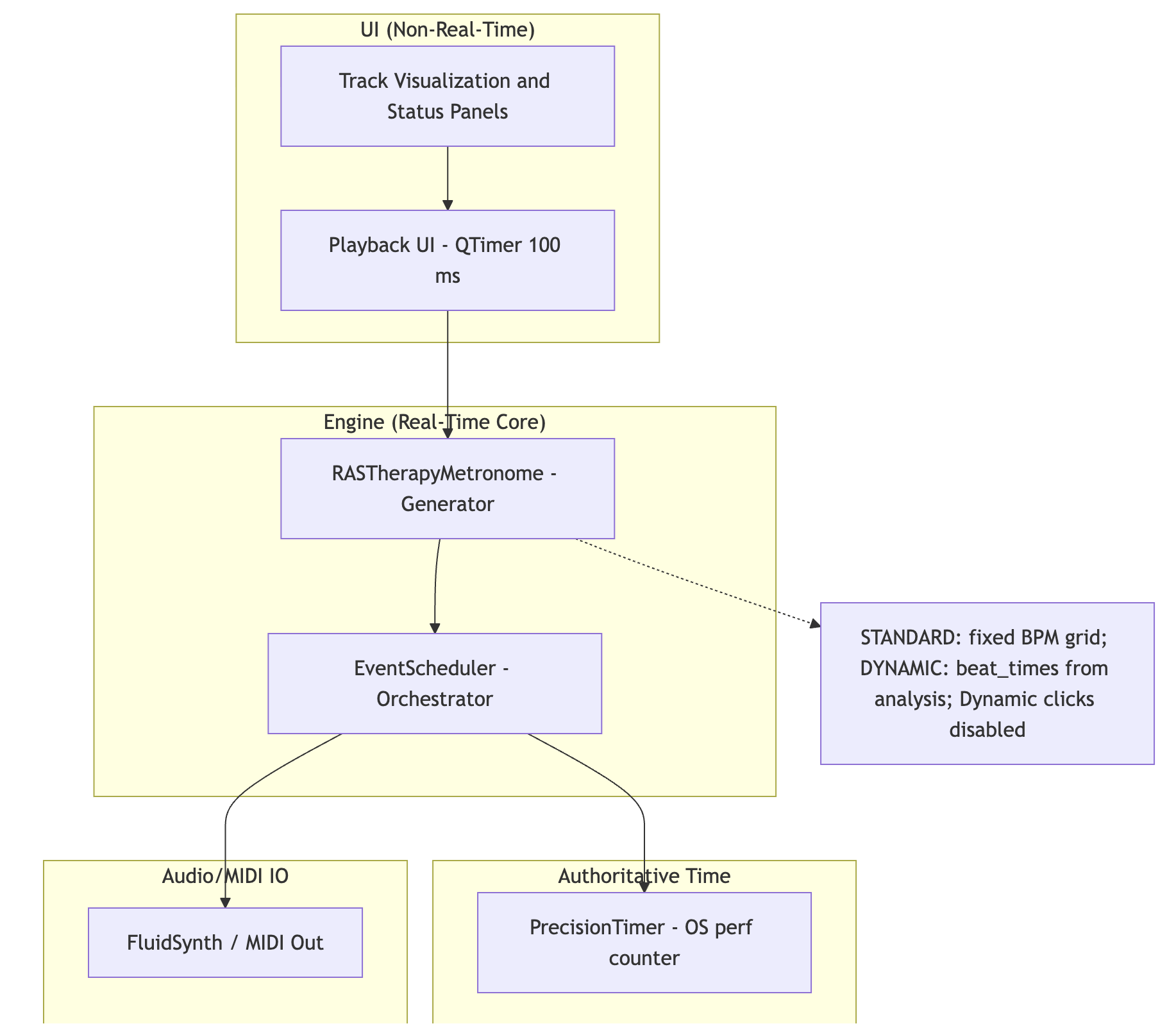A Hierarchical Timing Architecture
2. Architectural Components
The system’s design is predicated on a hierarchical model where each layer serves a specialized function, contributing to a predictable and accurate timing workflow.

2.1. The Authoritative Time Source
At the base of the hierarchy lies the Authoritative Time Source, the system's ultimate arbiter of elapsed time. This foundational layer is implemented using the host operating system’s high-performance monotonic clock. Unlike system wall clocks, which are subject to adjustments (e.g., from network time protocol updates) and can even move backward, a monotonic clock provides a strictly increasing, high-resolution count of time. This choice is critical, as it provides timestamps with an accuracy on the order of microseconds (±0.1ms), forming a stable and reliable foundation for all subsequent scheduling. The design explicitly forbids the use of general-purpose application timers or wall-clock time for any audio-related event, as these sources lack the requisite precision and stability.
2.2. The Event Dispatch Engine
The second tier is the Event Dispatch Engine, an orchestrator responsible for executing a pre-determined schedule of events. It maintains a time-sorted queue of all musical and metronomic events to be played. During playback, the engine operates in a tight loop, continuously polling the Authoritative Time Source. It compares the current high-precision timestamp to the timestamp of the next event in its queue. When the current time is greater than or equal to the scheduled event time, the engine dispatches the event to the audio synthesis pipeline.
A key responsibility of this layer is managing playback state. To handle pause and resume operations without drift, the engine calculates the elapsed time during a pause and offsets its internal clock accordingly upon resumption. This ensures that the temporal relationship between events remains intact. Furthermore, to guarantee thread-safe operation, the engine acquires an exclusive lock on the audio synthesizer before dispatching any event, preventing data corruption or race conditions that could otherwise manifest as audible artifacts.
2.3. The Rhythmic Event Generator
At the highest level of the hierarchy is the Rhythmic Event Generator. This component is responsible for creating the schedule of metronomic clicks that the Event Dispatch Engine will execute. Its logic is context-aware, adapting its output based on the musical properties of the loaded file and the desired operational mode. It supports two primary modes of schedule generation:
- Grid-Based Mode: In this mode, used for structurally regular music with reliable metadata, the generator creates a fixed-grid event schedule based on the musical tempo and time signature. This provides a conventional, metronomically perfect timeline.
- Analysis-Driven Mode: For music with expressive timing (rubato) or missing metadata, the generator ingests a pre-computed array of beat times derived from advanced signal analysis of the audio. It then uses this array to generate a dynamic event schedule that aligns precisely with the performer's actual rhythm.
This layer also handles sophisticated timing adjustments, such as applying non-destructive offsets to the entire schedule to compensate for anacrusis (pickup measures), ensuring the metronomic "one" aligns perfectly with the musical downbeat.
3. Integrated Workflow and Decoupling Principle
The synergy between these three layers creates a robust end-to-end workflow. When a user initiates playback, the Rhythmic Event Generator first produces a complete schedule of click events. This schedule is submitted to the Event Dispatch Engine, which queues them for execution. The engine then begins its main loop, governed by the Authoritative Time Source, dispatching each MIDI note and metronome click to the audio synthesizer at the precise moment it is scheduled to occur.
A core design principle of this architecture is the strict decoupling of the audio-critical timing path from the UI update loop. While the high-precision components manage audio events, a separate, low-priority timer is used exclusively for refreshing the graphical interface at a much lower frequency (e.g., every 100ms). This ensures that UI rendering, user input, and other non-deterministic processes cannot interfere with the timing of auditory cues, preserving the system's clinical and scientific integrity.
4. Conclusion
By employing a hierarchical architecture that separates timekeeping, dispatching, and schedule generation, this system achieves the high-precision timing necessary for demanding applications in music research and RAS therapy. The use of a monotonic clock as an authoritative source, combined with a deterministic event engine and a flexible schedule generator, provides a robust framework for delivering temporally accurate auditory stimuli, independent of system load and other external factors.
